America’s Original Gangster Couple, Trailblazing Women Explorers and Other New Books to Read
These March releases elevate overlooked stories and offer insights on oft-discussed topics
:focal(807x540:808x541)/https://tf-cmsv2-smithsonianmag-media.s3.amazonaws.com/filer/9b/77/9b773d59-173a-4171-a3a6-a0cba77c8c76/booksweek16.png)
At the height of the Roaring Twenties, the Whittemore Gang targeted banks and jewelry stores across the East Coast, stealing upward of $1 million in diamonds and precious gems (around $15 million today). Led by young couple Richard and Margaret Whittemore, known respectively as “the Candy Kid” and “Tiger Girl,” the group’s lavish lifestyle and violent escapades captured Americans’ attention much like the exploits of Bonnie and Clyde would less than a decade later.
In March 1926, after a year-long crime spree that left at least six dead, authorities finally caught up to the Whittemore Gang. As the New York Times reported shortly after his arrest, the Candy Kid appeared “cool and … indifferent”—at least until authorities mentioned his wife. Hearing her name, the 24-year-old offered authorities a deal: Release Margaret, and he would confess “the works, the whole works, and it will startle New York.“ This show of affection, writes Glenn Stout in Tiger Girl and the Candy Kid: America’s Original Gangster Couple, cemented the pair’s status as star-crossed lovers—and set the stage for a fittingly tragic ending to their story.
The latest installment in our series highlighting new book releases, which launched last year to support authors whose works have been overshadowed amid the Covid-19 pandemic, explores the Whittemores’ transformation from working-class Baltimore teenagers into career criminals, the founding of the Society of Women Geographers, the rise of the modern conservation movement, the lives of three friends who fought for abolition and women’s rights, and the challenges black Americans face when traveling.
Representing the fields of history, science, arts and culture, innovation, and travel, selections represent texts that piqued our curiosity with their new approaches to oft-discussed topics, elevation of overlooked stories and artful prose. We’ve linked to Amazon for your convenience, but be sure to check with your local bookstore to see if it supports social distancing–appropriate delivery or pickup measures, too.
Tiger Girl and the Candy Kid: America’s Original Gangster Couple by Glenn Stout
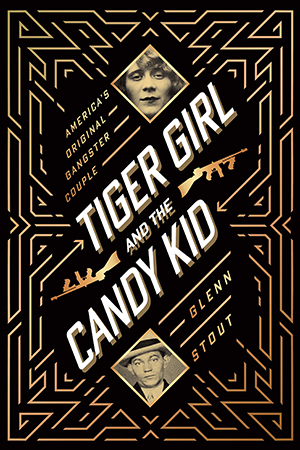
Eight days after his October 1921 wedding to Margaret Messler, Richard Whittemore pried a neighbor’s window open, snuck inside and filled a suitcase with stolen clothing and jewelry before nonchalantly walking out through the front door. Authorities caught up to the newlywed just over 24 hours later. Given his previous criminal record, which included a burglary conviction and subsequent stint at the Elmira Reformatory in New York, the judge handed down a harsh sentence: one to ten years in the Maryland State Penitentiary. As Richard, then 20 years old, settled into his new home, 18-year-old Margaret returned to her old one, moving back in with her mother after just a week of marriage.
The Whittemores’ life was a far cry from the hedonistic extravagance of F. Scott Fitzgerald’s Jazz Age characters. For them, writes Stout in Tiger Girl and the Candy Kid, the Roaring Twenties weren’t “about raccoon coats and cocktails, sis-boom-bah and profligate excess, but how those romanticized mythologies of the era provided an irresistible fantasy, and how trying to live that fantasy played out, life and death in real time.”
Richard spent his time in jail cozying up to career criminals and planning for his eventual return to society. Shortly after his release in April 1924, the couple carried out their first joint operation, stealing $350 in cash from a confectionary shop. Initially, the press dubbed the mysterious woman who’d held up a cashier at gunpoint the “Bob-Haired Bandit.” But as her crimes continued, she earned a new nickname: Tiger Girl, a sobriquet previously given to “just about any young flapper who committed a particularly heinous crime” but now associated largely with her, according to Stout. Margaret’s partner-in-crime, meanwhile, was dubbed the Candy Kid—a nod to both his sweet-talking ways and drug use.
Less than a year after his release from the state penitentiary, Richard was back inside. As he said upon hearing his sentence, however, “I won’t be there long.” Three weeks later, the Candy Kid assaulted a guard and forced another to free him at gunpoint. Over the next 12 months, notes Kirkus, the Whittemore Gang balanced bank robberies and jewelry heists with “all-night parties, luxury apartments, and fast cars.”
The group’s lifestyle quickly proved unsustainable, and by March 1926, both Richard and his accomplices were back in court. Impressionable young men and women who’d followed the gang’s crimes via sensationalized tabloid reports rallied to support its leaders, gathering outside the courthouse by the thousands. But while Margaret was released after providing incriminating information on other gang members, Richard, whose jailbreak had left one guard dead, received no such deal.
On August 13, 1926, the couple bid each other farewell for the final time. “Don’t mind, Marge,” Richard reportedly told his wife through the bars of his cell. “Be brave. My last thoughts will be of you.” A few hours later, the 24-year-old was hanged in the prison yard. Margaret lived out the rest of her life in relative obscurity, dying at home in 1993. As Stout writes, “Her death notice in the Baltimore Sun made no mention of her early life, or of Tiger Girl, and did not bother even to spell her name correctly.”
The Girl Explorers: The Untold Story of the Globetrotting Women Who Trekked, Flew, and Fought Their Way Around the World by Jayne Zanglein
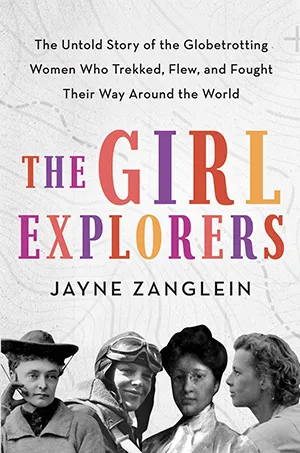
Established in 1925 by four friends hoping to push back against the Explorers Club’s refusal to admit female researchers, the Society of Women Geographers counts such luminaries as aviator Amelia Earhart, paleoanthropologist Mary Douglas Leakey, photojournalist Margaret Bourke-White and primatologist Jane Goodall among its members. In The Girl Explorers, author Jayne Zanglein details the society’s early days, as seen primarily through the eyes of co-founder Blair Niles, before shifting gears to later members’ accomplishments. As Publishers Weekly notes, Zanglein deftly conveys her subjects’ “common love for travel and exploration in an era when women were told their place was in the home.”
Niles, who launched the society in collaboration with Gertrude Emerson Sen, Marguerite Harrison and Gertrude Mathews Shelby, was a travel writer who used her position to “advocate for marginalized and oppressed people,” per The Girl Explorers. In the late 1920s and early ’30s, she penned two novels based on her travels, exposing dire prison conditions in French Guiana in the first and celebrating Harlem as a haven for gay men in the latter. According to Kirkus, Niles had previously made headlines for divorcing her husband, zoologist William Beebe, and promptly remarrying a younger man. Though Niles made significant contributions to Beebe’s research, he refused to acknowledge her work and even plagiarized her personal writings in his books.
Other women adventurers featured in The Girl Explorers include mountaineer Annie Peck, who, at the age of 58, became the first American to scale the 21,812-foot summit of Peru’s Mount Huascarán; biologist Gloria Hollister, who studied Bermuda’s marine life from within a 5,000-pound bathysphere, or deep-sea submersible; and Arctic explorer Louise Boyd, who was the first woman to fly over the North Pole.
“The women featured in the book proved that women were as capable explorers as men,” says Zanglein in a statement. “They broke a barrier so women today can travel and explore without discrimination.”
Beloved Beasts: Fighting for Life in an Age of Extinction by Michelle Nijhuis
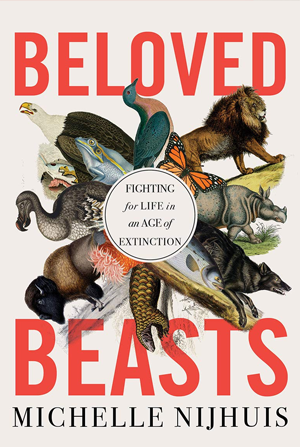
For much of human history, civilizations’ survival depended largely on other living creatures, from cattle butchered as food to animal skins used as clothing. But by the late 19th century, rapid industrialization and globalization had lessened many Western societies’ reliance on animals, giving rise to a group of “privileged North Americans and Europeans … [whose] location and education enabled them to recognize the effects of humans on other species, and [whose] money and class freed them to take controversial positions”: namely, writes science journalist Michelle Nijhuis in Beloved Beasts, that nature should be protected and conserved.
The modern conservation movement sparked by this argument is admittedly flawed. Many of its founders espoused racist views, prioritizing the preservation of pristine lands without considering the needs and desires of their Indigenous inhabitants. And, more often than not, conservationists’ efforts to save endangered species failed, depriving the world of its biodiversity.
Beloved Beasts fully acknowledges this shadowy past, as well as the movement’s decidedly challenging future. Far from succumbing to fatalism, however, Nijhuis’ history of conservation strikes hopeful notes, emphasizing activists’ “many victories” and increasing “political clout,” per Kirkus. Brief biographies of conservationists—from prominent figures like Rachel Carson and Aldo Leopold to lesser-known individuals such as William Hornaday, savior of the American bison, and Rosalie Edge, a socialite who founded the world’s first reserve for birds of prey—add color to the sweeping survey, while a future-focused conclusion outlines a call to action in the face of a likely sixth extinction.
“[Humans are] capable of restoration as well as destruction, reasoned decisions as well as thoughtless consumption,” writes Nijhuis. “To insist otherwise, to deny the full range of our complexity, would mean abandoning responsibility for the damage already done—and giving up on the hard-won potential of conservation.”
The Agitators: Three Friends Who Fought for Abolition and Women's Rights by Dorothy Wickenden
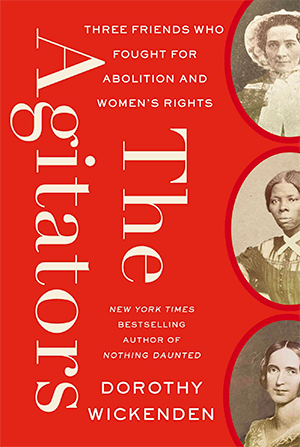
This engrossing biography from Dorothy Wickenden, executive editor of the New Yorker, catalogs the lives of three key figures in the abolitionist and women’s rights movements: Harriet Tubman, Martha Coffin Wright and Frances A. Seward. Tubman, who famously helped liberate some 70 people from slavery in the decade preceding the Civil War, struck up a friendship with Wright and Seward during the early 1850s, when the two women were living in Auburn, New York, a stopping point on one of her Underground Railroad routes.
Wright, a younger sister of suffragist Lucretia Mott and co-organizer of the 1848 Seneca Falls Convention, and Seward, wife of politician and future secretary of state William Henry Seward, were then “in the process of transforming themselves from conventional homemakers into insurgents,” writes Wickenden in The Agitators. The friends had previously bonded over their shared progressive views, but meeting Tubman further radicalized them, pushing Seward to open her home to escapees and offer financial support to freedom seekers. Later, when Tubman settled down in Auburn, Wright and Seward helped her “build and sustain a free Black community” there, according to Publishers Weekly.
Set between 1821 and 1875, The Agitators examines the major events of the mid-19th century, from Bleeding Kansas to the outbreak of war and assassination of Abraham Lincoln, through its three subjects’ unique points of view, as outlined in the regular correspondence they exchanged. As Kirkus points out, these tumultuous happenings “not only defined the revolutionary spirit of the era, but also caused divisions that still haunt the American soul today.” By spotlighting the bonds between Wright, Tubman and Seward—women separated by class and race but united by their dedication to human rights, notes Kirkus—Wickenden “offers hope for healing of old wounds and a future where ‘the dignity and equality of all Americans’ is an authentic reality.”
Traveling Black: A Story of Race and Resistance by Mia Bay
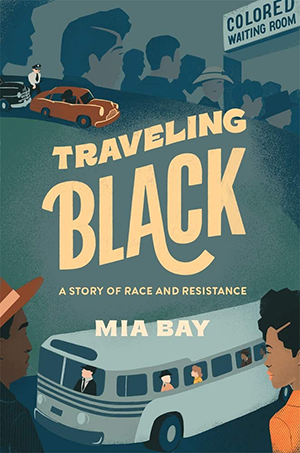
American identity is inextricably linked to freedom of movement. But for much of the nation’s history, black Americans have been barred from fully enjoying this freedom. “As new modes of transformation and accommodations developed,” writes historian Mia Bay in Traveling Black, “new forms of segregation followed,” from separate streetcars to roadside hotels that refused to serve black travelers and segregated airport restrooms.
Based on firsthand accounts and comprehensive archival research, Traveling Black details the manifest ways in which black Americans responded to limitations on their mobility. In 1922, for instance, Massachusetts minister Joseph K. Bowler told the Chicago Defender that he always carried a “Jim Crow traveling kit” made up of used overalls, a portable gas stove and a small table top. The overalls helped Bowler protect his clothing against the “dirty Jim Crow coaches,” whose seats were often covered in tobacco juice spat out by white conductors, while the other two tools enabled him to cook meals on the go without access to the whites-only dining car. “White people below the Mason-Dixon line maintain that we are animals, virtually camels, and can go without food or water for several days,” Bowler explained.
Traveling by train sometimes proved fatal for black passengers. Relegated to outdated wooden cars that rode directly behind the engine, these travelers were the most likely to die when crashes occurred. “[I]f you had 100 deaths,” says Bay in an interview with Penn Today, “at least 70 [percent] of them would be the Black people in the Jim Crow cars and most of the rest would be the engineer and the conductor and the other railroad workers, who often traveled in the Jim Crow cars.”
During the mid-20th century, when traveling by car became the norm, many black Americans found refuge within their private vehicles. But venturing outside of one’s car in the Jim Crow South could be both dangerous and demeaning—possibilities underscored by The Negro Motorist Green Book, which identified hotels and restaurants that welcomed or rejected black travelers.
Today, inadequate infrastructure and uneven access to public transportation pose major obstacles to black mobility. Per Publishers Weekly, black travelers continue to face “danger and discrimination in the form of higher prices for car insurance, less-reliable public transportation, and racial profiling by law enforcement.”
As Bay adds in the interview, “The way people move through the world is not something that we simply do as free agents. We move through the world easily or with more difficulty depending on how our society provides for us and depending on how our rights are protected.”
/https://tf-cmsv2-smithsonianmag-media.s3.amazonaws.com/accounts/headshot/mellon.png)
/https://tf-cmsv2-smithsonianmag-media.s3.amazonaws.com/accounts/headshot/mellon.png)